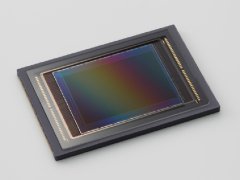News Release
Canon successfully develops world's first APS-H-size CMOS image sensor to realize record-high resolution of 120 megapixels
TOKYO, August 24, 2010—Canon Inc. announced today that it has successfully developed an APS-H-size*1 CMOS image sensor that delivers an image resolution of approximately 120 megapixels (13,280 x 9,184 pixels), the world's highest level*2 of resolution for its size.

Canon's newly developed CMOS sensor,
featuring approx. 120 megapixels
Compared with Canon's highest-resolution commercial CMOS sensor of the same size, comprising approximately 16.1 million pixels, the newly developed sensor features a pixel count that, at approximately 120 million pixels, is nearly 7.5 times larger and offers a 2.4-fold improvement in resolution.*3
With CMOS sensors, while high-speed readout for high pixel counts is achieved through parallel processing, an increase in parallel-processing signal counts can result in such problems as signal delays and minor deviations in timing. By modifying the method employed to control the readout circuit timing, Canon successfully achieved the high-speed readout of sensor signals. As a result, the new CMOS sensor makes possible a maximum output speed of approximately 9.5 frames per second, supporting the continuous shooting of ultra-high-resolution images.
Canon's newly developed CMOS sensor also incorporates a Full HD (1,920 x 1,080 pixels) video output capability. The sensor can output Full HD video from any approximately one-sixtieth-sized section of its total surface area.
Images captured with Canon's newly developed approximately 120-megapixel CMOS image sensor, even when cropped or digitally magnified, maintain higher levels of definition and clarity than ever before. Additionally, the sensor enables image confirmation across a wide image area, with Full HD video viewing of a select portion of the overall frame.
Through the further development of CMOS image sensors, Canon will break new ground in the world of image expression, targeting new still images that largely surpass those made possible with film, and video movies that capitalize on the unique merits of SLR cameras, namely their high mobility and the expressive power offered through interchangeable lenses.
- *1The imaging area of the newly developed sensor measures approx. 29.2 x 20.2 mm.
- *2As of August 20, 2010. Based on a Canon study.
- *3Canon's highest-resolution commercial CMOS sensor, employed in the company's EOS-1Ds Mark III and EOS 5D Mark II digital SLR cameras, is equivalent to the full-frame size of the 35 mm film format and incorporates approximately 21.1 million pixels. In 2007, the company successfully developed an APS-H-size sensor with approximately 50 million pixels.
